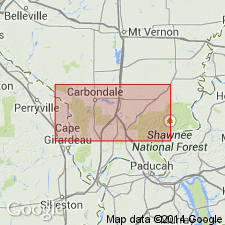
- Usage in publication:
-
- Waltersburg sandstone
- Modifications:
-
- Named
- Dominant lithology:
-
- Sandstone
- AAPG geologic province:
-
- Illinois basin
Summary:
Named Waltersburg sandstone. In southern IL, forms a lenticular body of sandstone some 40 mi across in an east-west direction. North-south dimension not known. Maximum thickness is 60 or 70 ft. Underlain by Vienna limestone; overlain by Menard limestone.
Source: GNU records (USGS DDS-6; Reston GNULEX).
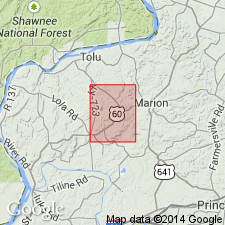
- Usage in publication:
-
- Waltersburg Sandstone*
- Modifications:
-
- Overview
- AAPG geologic province:
-
- Illinois basin
Summary:
Waltersburg Sandstone mapped with underlying Vienna Limestone. Upper 25-30 ft of Waltersburg is "Shale and siltstone: Shale is dark gray, contains abundant 0.02-inch siltstone or sandstone lenses; scattered siderite nodules. Siltstone is dark greenish gray; contains abundant interstitial chlorite; occurs in 3- to 5-foot bed in upper or lower part of unit; weathers brown with dark-red films along joint or bedding planes. Rhombohedra-like slivers of siltstone are present in overburden." Lower 5-10 ft is "Shale, dark-gray, commonly calcareous, contains scattered fossil fragments and siderite nodules. Rarely crops out. Waltersburg overlain by Menard Limestone.
Source: GNU records (USGS DDS-6; Reston GNULEX).
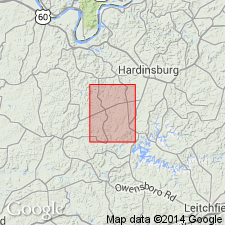
- Usage in publication:
-
- Waltersburg Member*
- Modifications:
-
- Revised
- AAPG geologic province:
-
- Illinois basin
Summary:
Waltersburg Sandstone reduced in rank to Waltersburg Member of Buffalo Wallow Formation. Mapped with underlying Vienna Limestone Member. Waltersburg is "Shale, sandstone, siltstone: Shale, light- to dark-gray and brown, clayey to sandy. Sandstone, yellowish-brown and grayish-yellow, fine- to medium-grained, ripple-marked, thin-bedded to massive beds as much as 12 feet thick; grades into hard brownish-yellow, green and olive-green very fine grained sandstone and siliceous siltstone. Overlain by Menard Limestone Member. Thickness is 0 to 60 ft.
Source: GNU records (USGS DDS-6; Reston GNULEX).
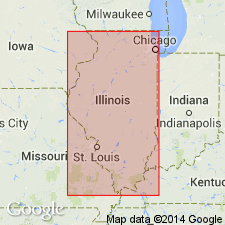
- Usage in publication:
-
- Waltersburg Formation
- Modifications:
-
- Overview
- AAPG geologic province:
-
- Illinois basin
Summary:
Current (1975) usage of Illinois Geological Survey is Waltersburg Formation. "It is a clastic unit consisting mainly of shale, but has beds of siltstone and sandstone." The shale is mainly dark gray and slightly carbonaceous, in part silty and sandy. Unit is 50-75 ft thick throughout most of IL. Underlain by Vienna Limestone; overlain by Menard Limestone. In IL, confined to southern part. Isopach map included.
Source: GNU records (USGS DDS-6; Reston GNULEX).
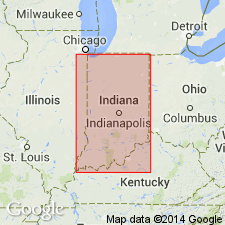
- Usage in publication:
-
- Waltersburg Sandstone
- Modifications:
-
- Overview
- AAPG geologic province:
-
- Illinois basin
Summary:
Current (1986) usage of Indiana Geological Survey is Waltersburg Sandstone of Buffalo Wallow Group. Usage is presently restricted to the subsurface. The name is restricted to lenticular sandstone bodies as much as 60 feet thick lying between the Vienna and Menard Limestones. In Indiana, it is known from Daviess County southwestward.
Source: GNU records (USGS DDS-6; Reston GNULEX).
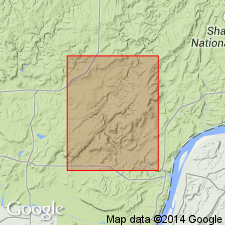
- Usage in publication:
-
- Waltersburg Formation
- Modifications:
-
- Revised
- AAPG geologic province:
-
- Illinois basin
Summary:
The Pope Group, here revised from Megagroup and apparently reinstated, comprises strata from the base of the Aux Vases Sandstone to the top of the Kinkaid Formation, which includes the Waltersburg Formation. According to authors, "The Pope Group is a lithostratigraphic unit distinct from its chronostratigraphic counterpart, the Chesterian Series." The lower boundaries of the two differ slightly. The group is about 1,425 ft thick in the Waltersburg quad, but the lowermost formations, from the Aux Vases Sandstone up to the Fraileys Shale Member of the Golconda Formation do not crop out. This interval is 384 ft thick in the Austin Roberts No. 1 Well. [See subunit list in index portion of Pope summary record. Publication does not name the units between the Aux Vases and the Fraileys and therefore these have not been included in the list.]
Source: GNU records (USGS DDS-6; Reston GNULEX).
For more information, please contact Nancy Stamm, Geologic Names Committee Secretary.
Asterisk (*) indicates published by U.S. Geological Survey authors.
"No current usage" (†) implies that a name has been abandoned or has fallen into disuse. Former usage and, if known, replacement name given in parentheses ( ).
Slash (/) indicates name conflicts with nomenclatural guidelines (CSN, 1933; ACSN, 1961, 1970; NACSN, 1983, 2005, 2021). May be explained within brackets ([ ]).

